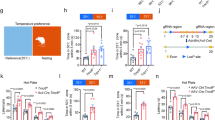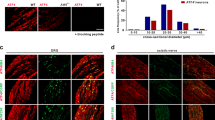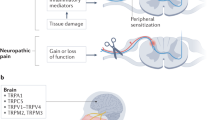Abstract
Nociceptors are a subset of small primary afferent neurons that respond to noxious chemical, thermal and mechanical stimuli. Ion channels in nociceptors respond differently to noxious stimuli and generate electrical signals in different ways. Anoctamin 1 (ANO1 also known as TMEM16A) is a Ca2+-activated chloride channel that is essential for numerous physiological functions. We found that ANO1 was activated by temperatures over 44 °C with steep heat sensitivity. ANO1 was expressed in small sensory neurons and was highly colocalized with nociceptor markers, which suggests that it may be involved in nociception. Application of heat ramps to dorsal root ganglion (DRG) neurons elicited robust ANO1-dependent depolarization. Furthermore, knockdown or deletion of ANO1 in DRG neurons substantially reduced nociceptive behavior in thermal pain models. These results indicate that ANO1 is a heat sensor that detects nociceptive thermal stimuli in sensory neurons and possibly mediates nociception.
This is a preview of subscription content, access via your institution
Access options
Subscribe to this journal
Receive 12 print issues and online access
$209.00 per year
only $17.42 per issue
Buy this article
- Purchase on SpringerLink
- Instant access to full article PDF
Prices may be subject to local taxes which are calculated during checkout






Similar content being viewed by others
References
Basbaum, A.I., Bautista, D.M., Scherrer, G. & Julius, D. Cellular and molecular mechanisms of pain. Cell 139, 267–284 (2009).
Perl, E.R. Ideas about pain, a historical view. Nat. Rev. Neurosci. 8, 71–80 (2007).
Caterina, M.J. Transient receptor potential ion channels as participants in thermosensation and thermoregulation. Am. J. Physiol. Regul. Integr. Comp. Physiol. 292, R64–R76 (2007).
Dhaka, A., Viswanath, V. & Patapoutian, A. Trp ion channels and temperature sensation. Annu. Rev. Neurosci. 29, 135–161 (2006).
Talavera, K., Nilius, B. & Voets, T. Neuronal TRP channels: thermometers, pathfinders and life-savers. Trends Neurosci. 31, 287–295 (2008).
Caterina, M.J. et al. The capsaicin receptor: a heat-activated ion channel in the pain pathway. Nature 389, 816–824 (1997).
Tominaga, M. et al. The cloned capsaicin receptor integrates multiple pain-producing stimuli. Neuron 21, 531–543 (1998).
Caterina, M.J. et al. Impaired nociception and pain sensation in mice lacking the capsaicin receptor. Science 288, 306–313 (2000).
Davis, J.B. et al. Vanilloid receptor-1 is essential for inflammatory thermal hyperalgesia. Nature 405, 183–187 (2000).
Caterina, M.J., Rosen, T.A., Tominaga, M., Brake, A.J. & Julius, D. A capsaicin-receptor homologue with a high threshold for noxious heat. Nature 398, 436–441 (1999).
Hu, H.Z. et al. 2-aminoethoxydiphenyl borate is a common activator of TRPV1, TRPV2 and TRPV3. J. Biol. Chem. 279, 35741–35748 (2004).
Jordt, S.E. et al. Mustard oils and cannabinoids excite sensory nerve fibres through the TRP channel ANKTM1. Nature 427, 260–265 (2004).
Macpherson, L.J. The pungency of garlic: activation of TRPA1 and TRPV1 in response to allicin. Curr. Biol. 15, 929–934 (2005).
Karashima, Y. et al. TRPA1 acts as a cold sensor in vitro and in vivo. Proc. Natl. Acad. Sci. USA 106, 1273–1278 (2009).
Story, G.M. et al. ANKTM1, a TRP-like channel expressed in nociceptive neurons, is activated by cold temperatures. Cell 112, 819–829 (2003).
Woodbury, C.J. et al. Nociceptors lacking TRPV1 and TRPV2 have normal heat responses. J. Neurosci. 24, 6410–6415 (2004).
Hartzell, C., Putzier, I. & Arreola, J. Calcium-activated chloride channels. Annu. Rev. Physiol. 67, 719–758 (2005).
Frings, S., Reuter, D. & Kleene, S.J. Neuronal Ca2+ -activated Cl− channels—homing in on an elusive channel species. Prog. Neurobiol. 60, 247–289 (2000).
Cia, D. et al. Voltage-gated channels and calcium homeostasis in mammalian rod photoreceptors. J. Neurophysiol. 93, 1468–1475 (2005).
Lalonde, M.R., Kelly, M.E. & Barnes, S. Calcium-activated chloride channels in the retina. Channels (Austin) 2, 252–260 (2008).
Kleene, S.J. High-gain, low-noise amplification in olfactory transduction. Biophys. J. 73, 1110–1117 (1997).
Lowe, G. & Gold, G.H. Nonlinear amplification by calcium-dependent chloride channels in olfactory receptor cells. Nature 366, 283–286 (1993).
Caputo, A. et al. TMEM16A, a membrane protein associated with calcium-dependent chloride channel activity. Science 322, 590–594 (2008).
Schroeder, B.C., Cheng, T., Jan, Y.N. & Jan, L.Y. Expression cloning of TMEM16A as a calcium-activated chloride channel subunit. Cell 134, 1019–1029 (2008).
Yang, Y.D. et al. TMEM16A confers receptor-activated calcium-dependent chloride conductance. Nature 455, 1210–1215 (2008).
Voets, T. & Nilius, B. TRPs make sense. J. Membr. Biol. 192, 1–8 (2003).
Vyklický, L. et al. Temperature coefficient of membrane currents induced by noxious heat in sensory neurones in the rat. J. Physiol. (Lond.) 517, 181–192 (1999).
Large, W.A. & Wang, Q. Characteristics and physiological role of the Ca2+-activated Cl− conductance in smooth muscle. Am. J. Physiol. 271, C435–C454 (1996).
Hans, G., Deseure, K. & Adriaensen, H. Endothelin-1-induced pain and hyperalgesia: a review of pathophysiology, clinical manifestations and future therapeutic options. Neuropeptides 42, 119–132 (2008).
Lang, P.M. Characterization of neuronal nicotinic acetylcholine receptors in the membrane of unmyelinated human C-fiber axons by in vitro studies. J. Neurophysiol. 90, 3295–3303 (2003).
Zholos, A. Ca2+- and volume-sensitive chloride currents are differentially regulated by agonists and store-operated Ca2+ entry. J. Gen. Physiol. 125, 197–211 (2005).
Kaneko, H., Putzier, I., Frings, S. & Gensch, T. Determination of intracellular chloride concentration in dorsal root ganglion neurons by fluorescence lifetime imaging. in Calcium-Activated Chloride Channels (ed. Fuller, C.M.) 167–189 (Academic, San Diego, 2002).
Rocha-González, H.I., Mao, S. & Alvarez-Leefmans, F.J. Na+, K+, 2Cl− cotransport and intracellular chloride regulation in rat primary sensory neurons: thermodynamic and kinetic aspects. J. Neurophysiol. 100, 169–184 (2008).
Rock, J.R., Futtner, C.R. & Harfe, B.D. The transmembrane protein TMEM16A is required for normal development of the murine trachea. Dev. Biol. 321, 141–149 (2008).
Shibata, M. et al. Type F scavenger receptor SREC-I interacts with advillin, a member of the gelsolin/villin family, and induces neurite-like outgrowth. J. Biol. Chem. 279, 40084–40090 (2004).
Hasegawa, H., Abbott, S., Han, B.X., Qi, Y. & Wang, F. Analyzing somatosensory axon projections with the sensory neuron–specific Advillin gene. J. Neurosci. 27, 14404–14414 (2007).
Price, T.J., Cervero, F., Gold, M.S., Hammond, D.L. & Prescott, S.A. Chloride regulation in the pain pathway. Brain Res. Rev. 60, 149–170 (2009).
Alvarez-Leefmans, F.J. Chloride transporters in presynaptic inhibition, pain and neurogenic inflammation. in Physiology and Pathology of Chloride Transporters and Channels in the Nervous System (eds. Alvarez-Leefmans, F.J. & Delpire, E.) 439–470 (Academic, London, 2009).
Willis, W.D. John Eccles' studies of spinal cord presynaptic inhibition. Prog. Neurobiol. 78, 189–214 (2006).
Labrakakis, C., Tong, C.K., Weissman, T., Torsney, C. & MacDermott, A.B. Localization and function of ATP and GABAA receptors expressed by nociceptors and other postnatal sensory neurons in rat. J. Physiol. (Lond.) 549, 131–142 (2003).
Scott, R.H., Sutton, K.G., Griffin, A., Stapleton, S.R. & Currie, K.P. Aspects of calcium-activated chloride currents: a neuronal perspective. Pharmacol. Ther. 66, 535–565 (1995).
Willis, E.F., Clough, G.F. & Church, M.K. Investigation into the mechanisms by which nedocromil sodium, frusemide and bumetanide inhibit the histamine-induced itch and flare response in human skin in vivo. Clin. Exp. Allergy 34, 450–455 (2004).
Vriens, J. et al. TRPM3 is a nociceptor channel involved in the detection of noxious heat. Neuron 70, 482–494 (2011).
Xiao, B., Coste, B., Mathur, J. & Patapoutian, A. Temperature-dependent STIM1 activation induces Ca2+ influx and modulates gene expression. Nat. Chem. Biol. 7, 351–358 (2011).
Zhang, S.L. et al. STIM1 is a Ca2+ sensor that activates CRAC channels and migrates from the Ca2+ store to the plasma membrane. Nature 437, 902–905 (2005).
Koo, J.Y. et al. Hydroxy-alpha-sanshool activates TRPV1 and TRPA1 in sensory neurons. Eur. J. Neurosci. 26, 1139–1147 (2007).
Acknowledgements
This work was supported by the World Class University project (R31-2011-00101030), the Creative Research Initiatives Program (20120001246) and a grant (2011K000275) from the Brain Research Center of the 21st Century Frontier Research Program funded by of the Ministry of Education and Science and Technology and the National Research Foundation of the Republic of Korea.
Author information
Authors and Affiliations
Contributions
H.C. carried out the patch clamp and behavioral studies and analyzed data. Y.D.Y. and Y.J. performed molecular biological work. J.L. and T.K. performed patch-clamp recordings. B.L., F.W., R.R. and J.N.W. generated CKO mice. S.K.B. and H.S.N. carried out behavioral studies. B.D.H. generated ANO1 systemic knockout mice. U.O. wrote the manuscript and supervised the project.
Corresponding author
Ethics declarations
Competing interests
The authors declare no competing financial interests.
Supplementary information
Supplementary Text and Figures
Supplementary Figures 1–9 (PDF 718 kb)
Rights and permissions
About this article
Cite this article
Cho, H., Yang, Y., Lee, J. et al. The calcium-activated chloride channel anoctamin 1 acts as a heat sensor in nociceptive neurons. Nat Neurosci 15, 1015–1021 (2012). https://doi.org/10.1038/nn.3111
Received:
Accepted:
Published:
Issue Date:
DOI: https://doi.org/10.1038/nn.3111



